This week for Flora and Fauna Friday, it’s a trio of our cold weather sea-ducks, the Scoters of genus Melanitta.
Scoters are large sea-ducks that can be spotted buoyed off our coastline in winter. We have three species found all up the Eastern Seaboard, the Black Scoter (M. americana), Surf Scoter (M. perspicillata), and White-winged Scoter (M. deglandi). All three of our Scoters are large, dark-colored ducks. Their genus, Melanitta, literally translates to “black duck”. Fittingly, males of all three species are jet-black and females all a dark ebony-brown. As sea-ducks they, predictably, live out at sea. In South Carolina, they’re found almost exclusively floating on saltwater. Scoters are most prevalent and easy to see in the surf along our beaches, especially near river inlets, jetties, and groins. Their diet here in the Lowcountry is almost entirely shellfish, specifically mussels, clams, and other bivalves. Scoters dive underwater to pluck small clams out of the sand, wrench mussels off of rocks, and break off small oysters off of pylons. Scoters swallow shellfish whole and grind them to dust in their powerful gizzard.

Black Scoters are by far our most common Scoter species in the Lowcountry. Males are jet-black from tail to nose, except for a prominent tangerine-orange knob on top of their bill. Female Black Scoters are a dark grayish-brown throughout, except for pale cheeks that extend from below the eye and the base of their bill down to the nape of their neck. Black Scoters also have an obvious forehead, which the other two species tend to lack.
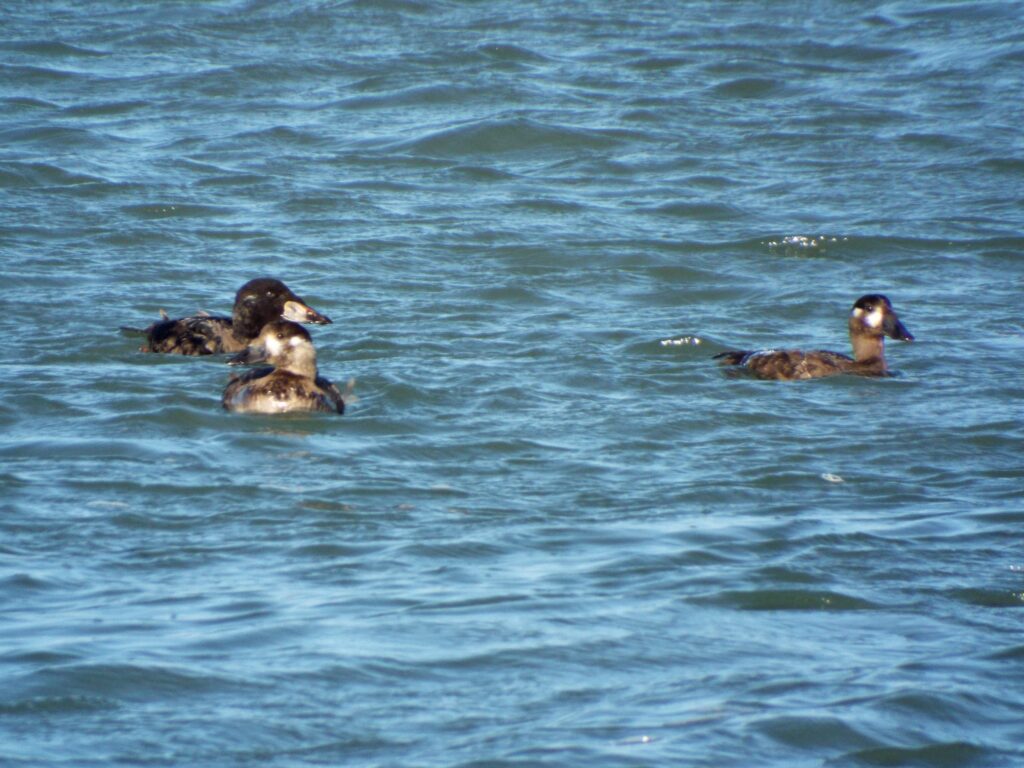
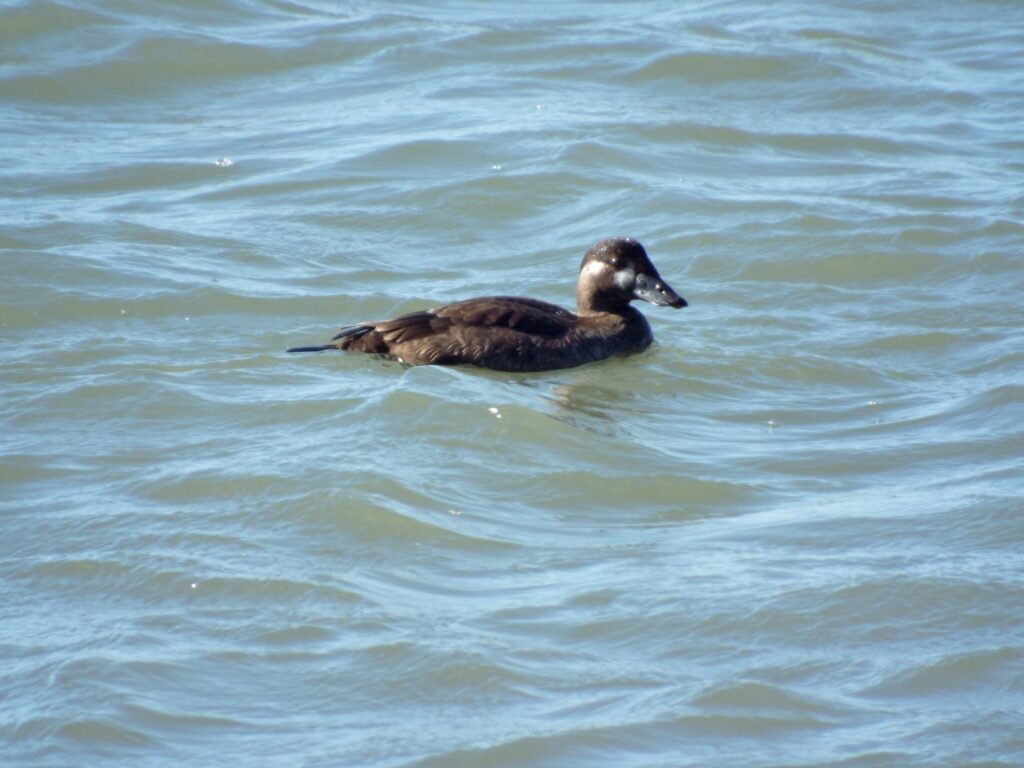
Surf Scoters are the next most common Scoter around Edisto Island. Males are ink-black across the body accented by a white nape, white forehead, white eyes, and a multicolored schnoz that is something to behold! Their bill runs straight back to the top of their head and is patterned with red, orange, and white surrounding a large black spot towards the base of the bill. Female Surf Scoters are a dark ebony-brown in color with a large, triangular bill and two pale spots on the face, one spot at the base of the bill and one back behind the eye.
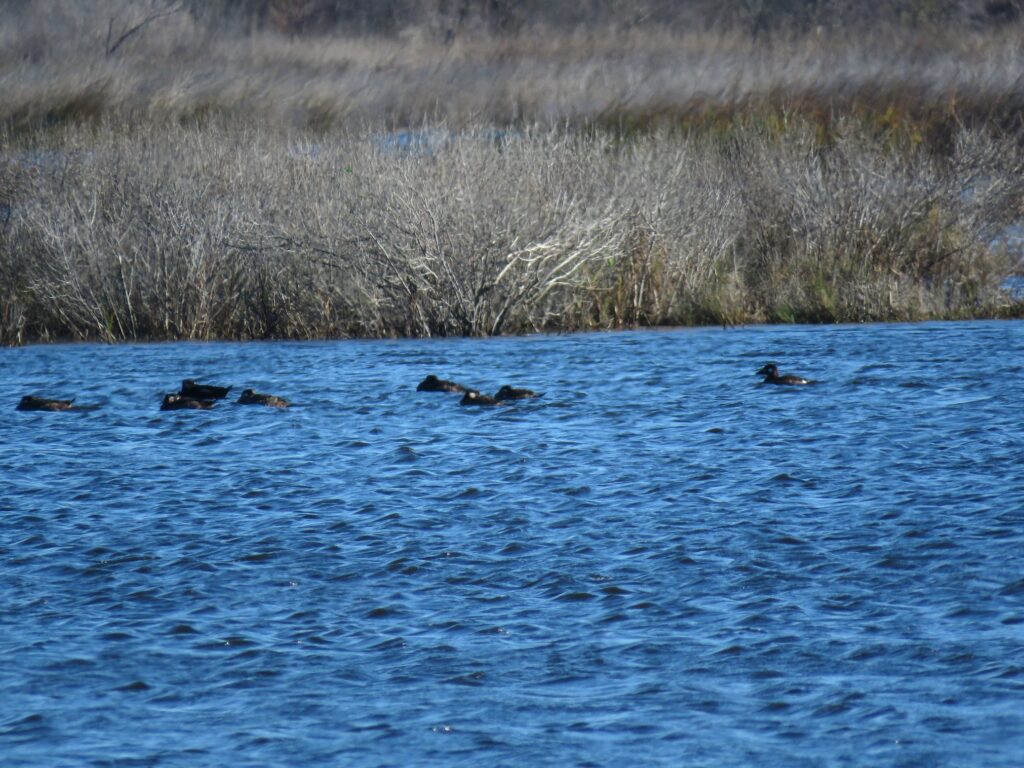
White-winged Scoters are our hardest scoter to find but the easiest to identify on the wing. Males are mainly black but have walnut-brown flanks and a snow-white speculum in the middle of their wing. They also sport white eyes, white eye-bags, and their own impressive schnoz, this one with a pink tip and a prominent black knob on top but while still retaining the semblance of a forehead. Female White-winged Scoters are very similar in appearance to female Surf Scoters. However, they have that prominent white wing patch and their feathers of their face extend down the bill to their nares, AKA nostrils. This means the pale spot at the base of their bill also extends further forward on the face towards the nares, whereas on the Surf Scoter it ends sharply at the bill.

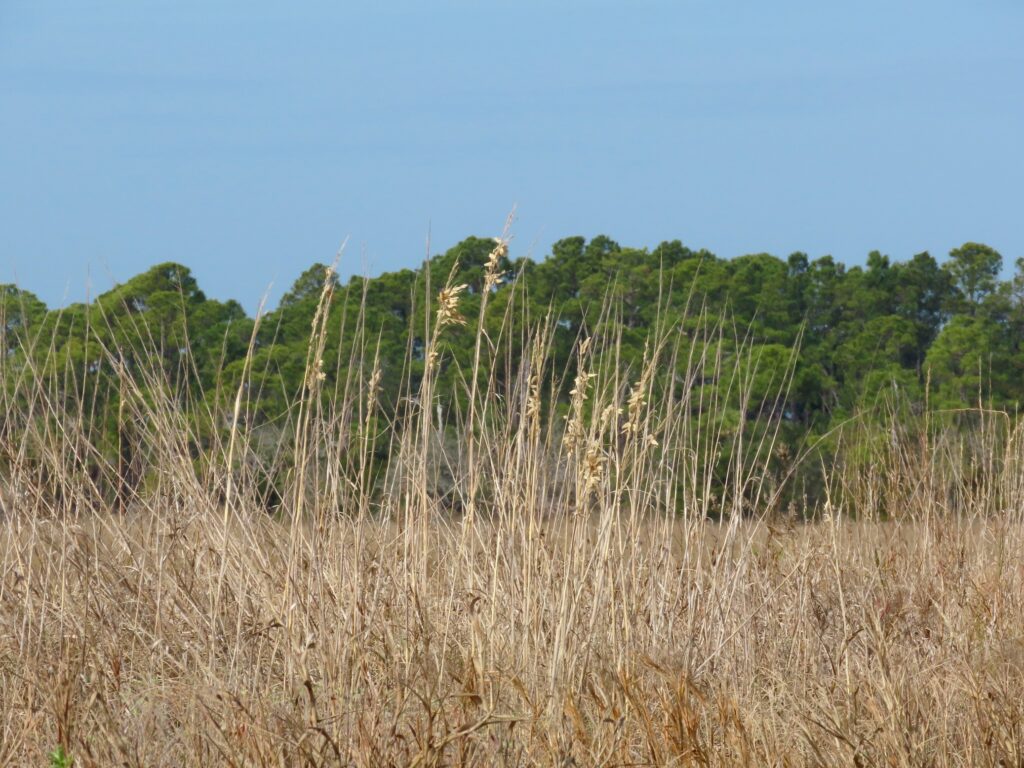
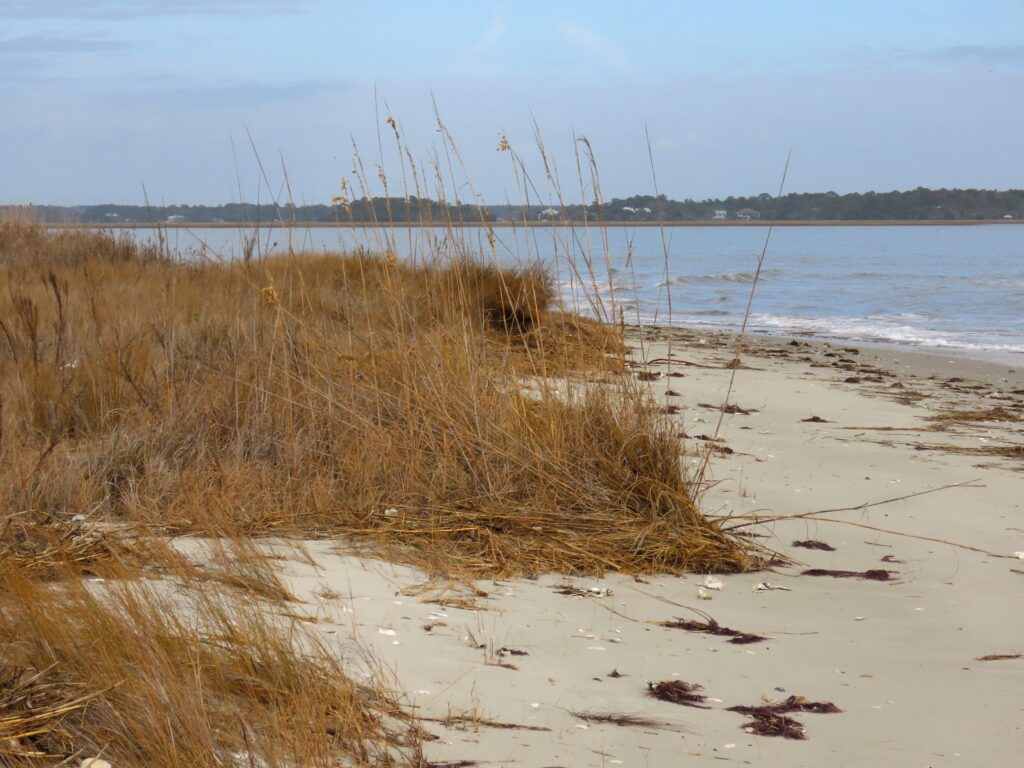

This week for Flora and Fauna Friday it’s the banner of the beach, Sea-Oats (Uniola paniculata).
Sea-Oats are a perennial species of grass native to the Atlantic Seaboard from the Chesapeake Bay south. It grows in clonal colonies with clumping bunches of blades arching up below knee-height. Those blades take on a bluish hue across its calico collage of young yellow-green and aged khaki-tan leaves. In winter it withers to a monotone khaki cast of foliage. But, its most defining feature is its flowers and fruits. The flower stalks of Sea-Oats reach high above the dunes, up to some seven feet in height. A singular stem crowned in a panicle of pendulous flattened flowers fluttering to and fro. A shape that inspires comparison to fertile fields of cultivated Oats (Avena sativa). These are wind-pollinated grass flowers, so showy is not their goal, but pleasing aesthetics emerged nonetheless. As the winds whip and blow along the shore, it pollinates these flowers before finally flinging their seeds sideways along the sands.
Sea-Oats live their lives on the narrowest of margins, just that thin strip of sand that constitutes our beach dune ecosystem. Beach dunes are one of the harshest environments for a plant that can be found in South Carolina. Beach sand retains next to no water and is nearly devoid of certain necessary nutrients. Simultaneously, the near unceasing sea breeze and singeing salt spray will wring every drop of moisture from most any plant. Yet, Sea-Oats are among the select few that can not only tolerate, but thrive in this hostile environment. Beyond even that, it’s what builds and bolsters these dunes to begin with. Sea-Oats are what we call an ecosystem engineer. Barrier island ecosystems, and in particular the beach dune systems, are contenders for having the most dynamic conditions of any natural environment. From year to year islands vanish and appear, beaches stretch and shrink, the water line ebbs and flows, inlets open and close, and dunes roll and fold atop themselves like a mirror of the surf in slow motion. Sea-Oats bring a semblance of stability to the chaos of the coast. Their expansive, fibrous roots grow out and down while their leaves grow upward and interlocking to raise a natural series of sand fences that intercept windblown sand and trap it beneath their net-like root system. This serves to build the dunes up over time and then anchors their shifting sands in place. This allows the dunes to resist erosion from the persistent slashing of wind and lapping of tides as well as the sudden smothering of a storm surge. This stability allows Sea-Oats to persist from year to year and lets them pour the semblance of a foundation for an ecosystem to build up around them.
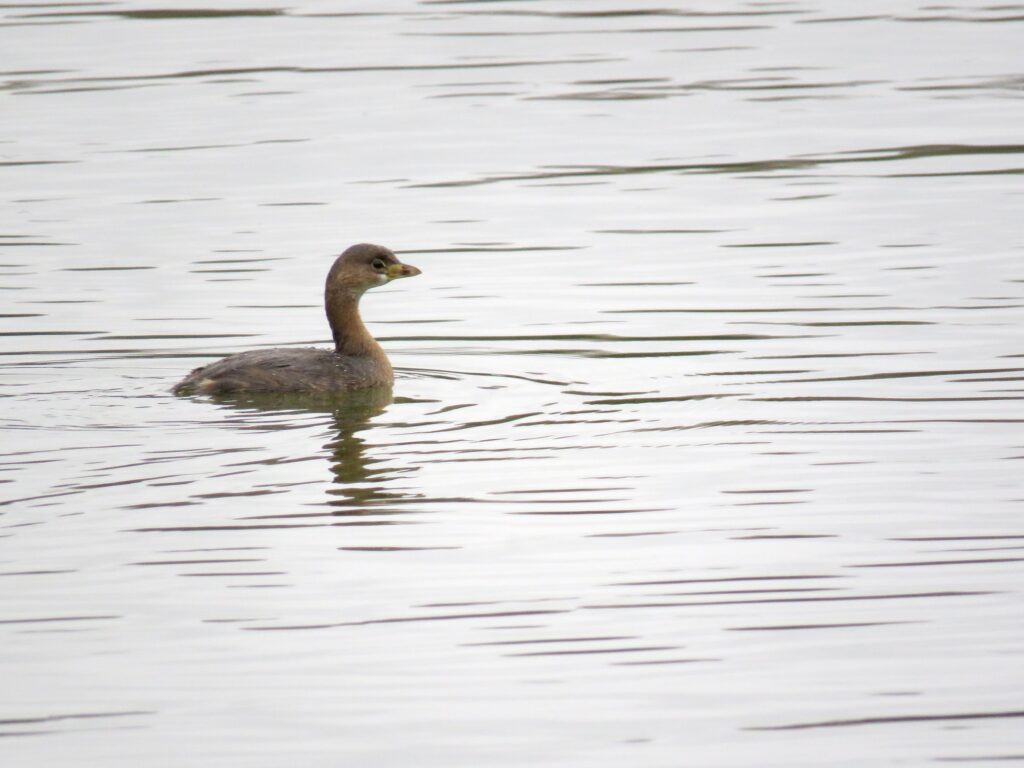

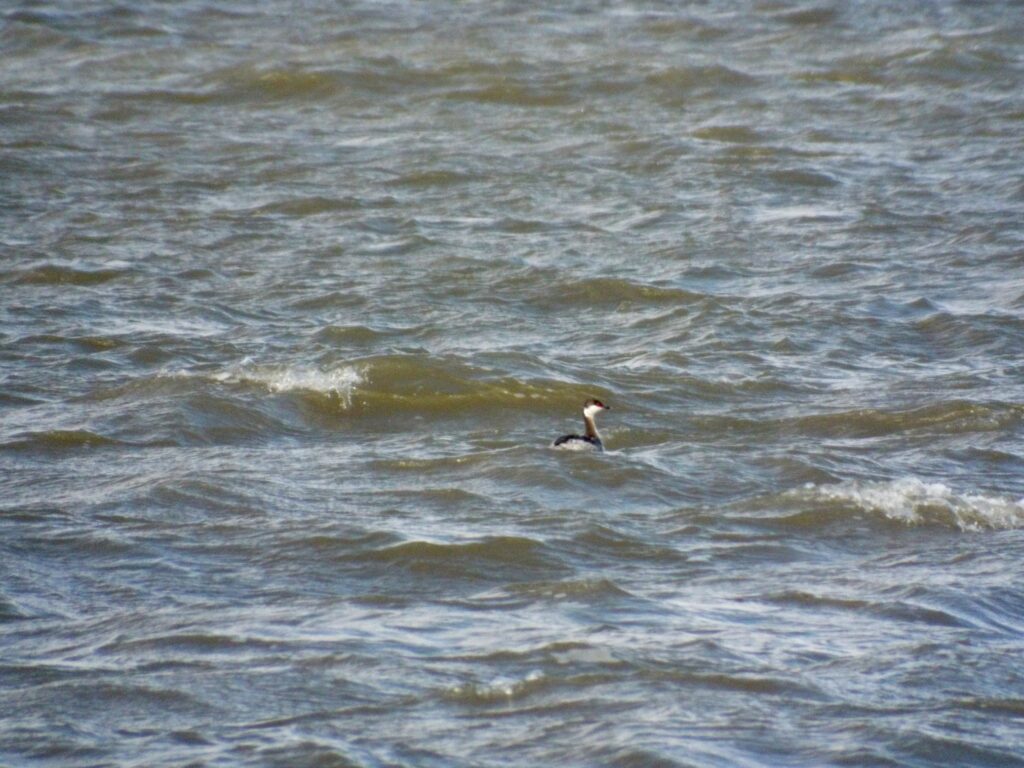
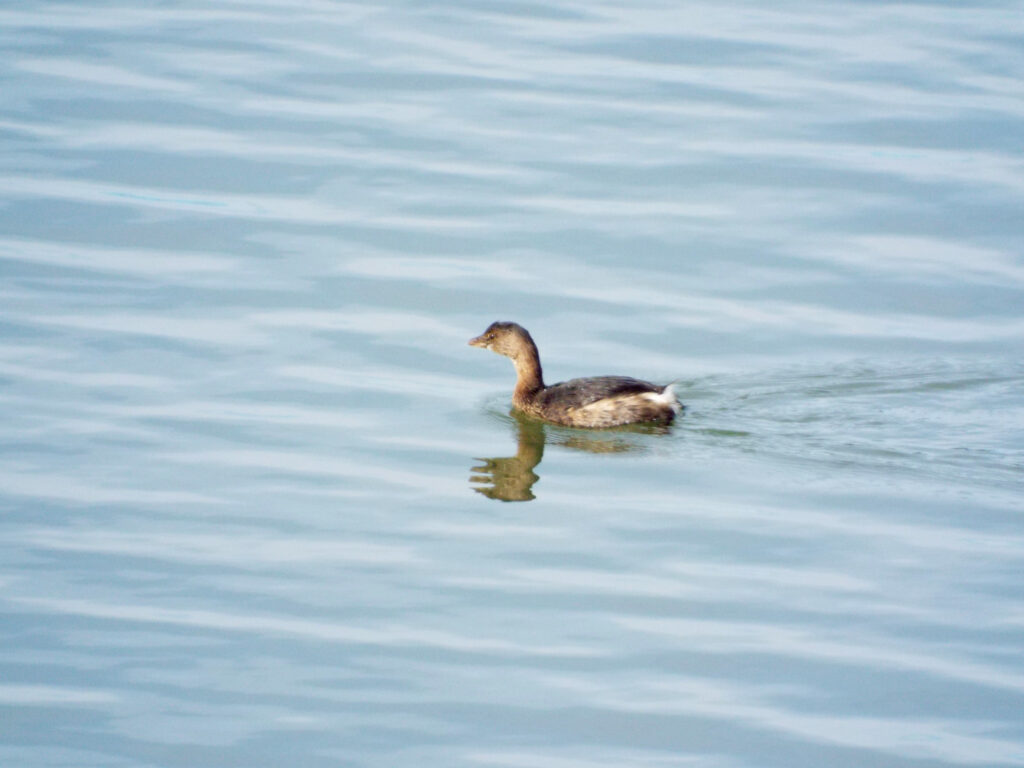
This week for Flora and Fauna Friday it’s an odd pair of not-quite-ducks, the Pied-billed Grebe (Podilymbus podiceps) and the Horned Grebe (Podiceps auritus).
A light fog folds and wraps around a pond, a wispy woolen blanket on a chilly winter morning. With the stab of first light the fog recoils and rolls aside to let the waters greet the day, revealing a small and curious shape paddling away. A Grebe taking its leave. Here on Edisto Island we welcome two species of Grebe each winter, the Pied-billed Grebe and the Horned Grebe. Both are small water-birds that stand out from all the rest. Grebes sit lower in the water than most, with short pointed bills, a head that seems a little small, and a neck that looks just a little too long. Grebes also have paddle-like feet, with each toe being flattened, which propel them across the water as they cruise or when getting a running start to take flight. They inhabit open water habitats and hunt by diving underwater to pursue prey. Their diet is primarily crustaceans, small fish, aquatic insects, and mollusks. Our two Grebes occupy different ecological niches and are starkly different in appearance.
Pied-billed Grebes in winter are a uniform walnut-brown only accented by a more umbral shaded mantle and a white rear-end. Their beady eye is set in a thin, pale ring and their short but robust bone-colored bill is split in twain by a dark bar. Our Pied-billed Grebe is a year-round resident, although far more numerous on Edisto in winter. When wearing their summer best, they don’t look all too different, but their bill bleaches to a pearl white and is starkly split by an oil-black band. This bicolored bill gives them the “pied” in their common name, which simply means black and white. A Pied-billed Grebe’s shape is more compact than other Grebes and their drab plumage can make them hard to discern from other floating fowl at a glance, but their low buoyancy and small head will shortly let you resolve them. Pied-billed Grebes are partial to calm and shallow ponds, lakeshores, and brackish impoundments. They can be found all across the state in these quiet water bodies. They also have a curious habit of sometimes sinking, rather than diving, especially when they’d rather not be seen.
The Horned Grebe in winter is a bicolor blend of snow-white below and shale gray above. Their neck is longer and their bill more knife-like than the Pied-billed Grebe. Yet this drab appearance is shattered by a blatant and brilliant ruby-red eye. In their summer breeding plumage, which we almost never see in the Lowcountry, these drab tones are eschewed for rich cinnamon, deep ebony, golden khaki, and ink-stained black. Horned Grebes are most easily spotted on Edisto bobbing in the surf along our beaches or riding the tides in our river inlets. They brave far more harrowing habitats and salty shores than the pond loving Pied-billed. Horned Grebes have also taken a liking to manmade lake reservoirs in the upstate, where both our Grebes can now sometimes be seen cohabitating.
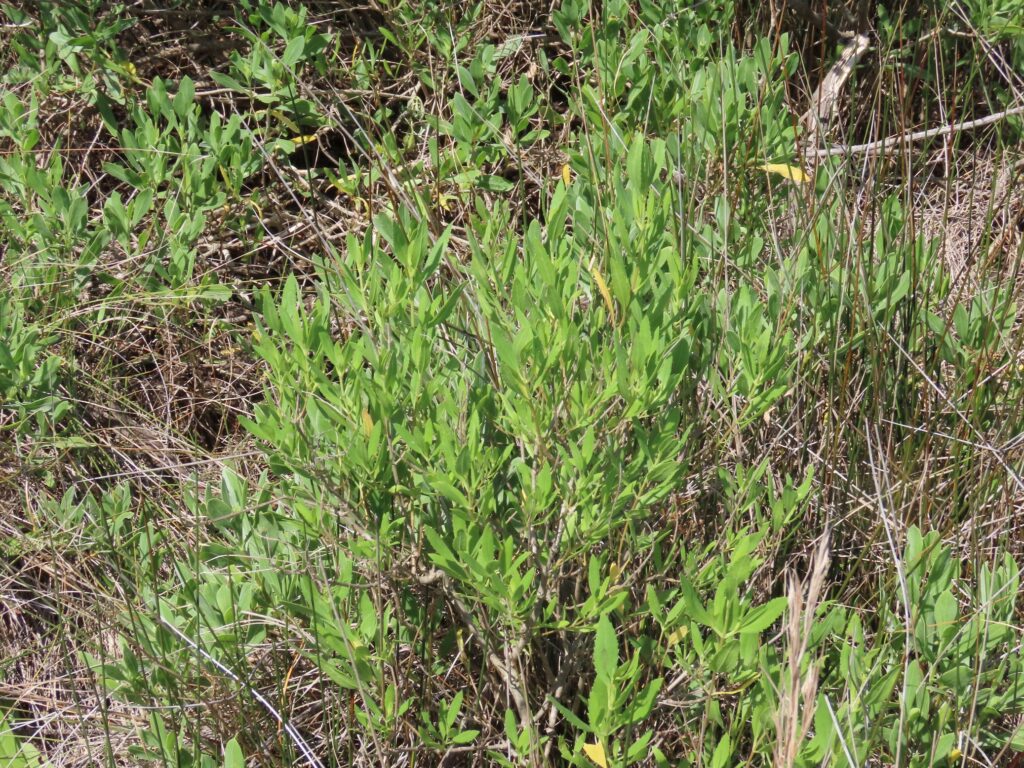
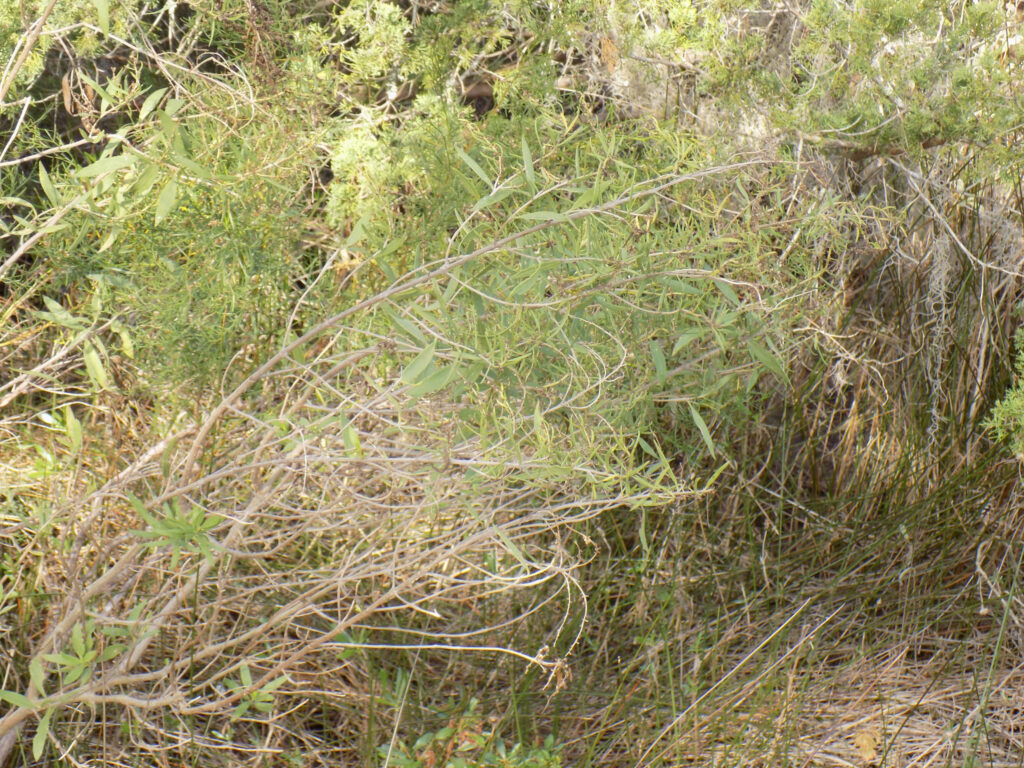
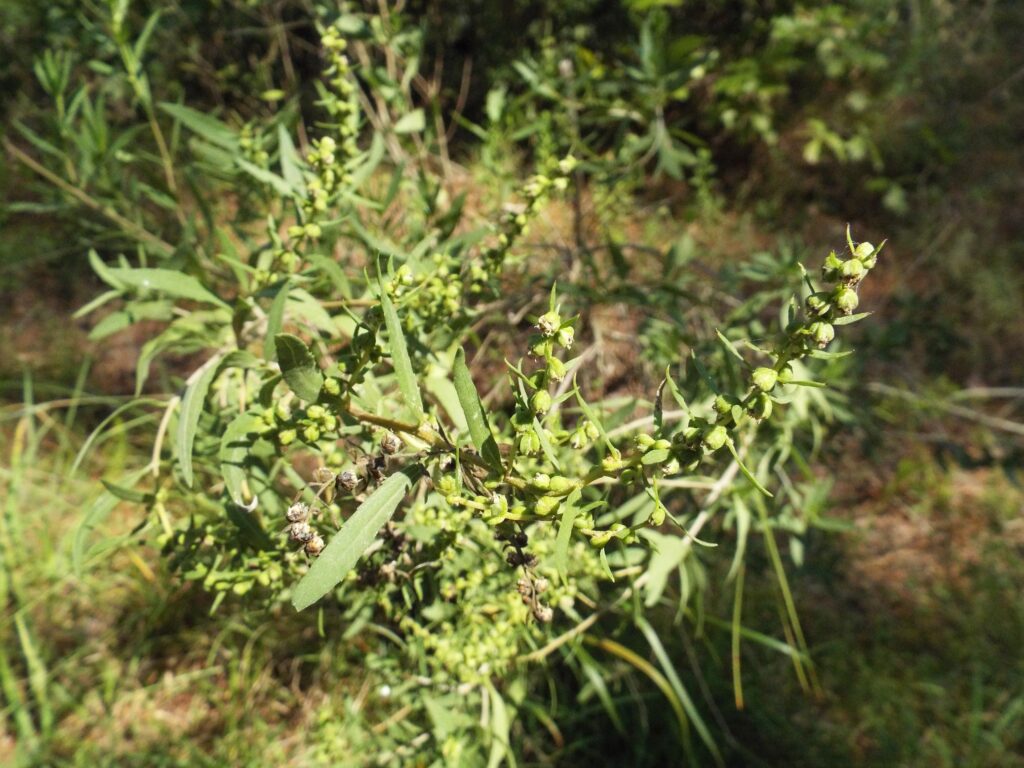
This week for Flora and Fauna Friday it’s another one of our salty shrubs, Marsh-Elder (Iva frutescens).
Marsh Elder is a woody, perennial shrub found all along the Eastern Seaboard of the United States and on the shores of all our tidal creeks here on Edisto Island. It grows head high with upward reaching branches. Its leaves, simple and elliptical, are arranged oppositely with a lightly-toothed margin and thick, leathery texture. Like many of our salt marsh shrubs, Marsh-Elder has fleshy leaves which allows it to store water and resist its preferred hot and salt-soaked habitat. Its leaves are semi-evergreen, or “tardily deciduous” as they say, meaning it sheds its leaves in winter or early spring, rather than fall. Marsh-Elder is easiest to identify after they start to bloom in summer. Each stem will produce a flower stalk at its tip with gradually shrinking leaves spiraling through a column of small, inconspicuous, green and cream-colored flowers. These flowers mature into small, round, dry fruits that persist into winter. Their seeds provide a valuable food source to many marsh birds and their large, brushy branches offer valuable cover and king-tide refuges for those same saltmarsh songbirds.



This week for Flora and Fauna Friday we have an elusive feline that’s long on legs and short on tails, the Bobcat (Lynx rufus).
The Bobcat is a small feline native to practically all of the lower 48 states and found throughout South Carolina. They are adapted to a wide-range of habitats and can be spotted skulking almost anywhere, but are most prolific here in the coastal plain. They look a fair bit like a domestic cat at a glance but with some key physical differences. Bobcats are tall and lanky with long legs and a long body. They stand about a foot-and-a-half at the shoulder and are roughly two-foot long. They have big feet, jowls with long fur, black tufts of hair at the tips of their ears, and of course, their namesake bobbed tail. Their fur is often grayish and reddish browns with thin black stripes on the face, small black dots along the legs and body, black bars on the tail, and a white belly. They also have white spots on the backs of their ears, white beneath their eyes, and a white underside to their tail.
As common as Bobcats are, they are a hard critter to lay eyes on, owing to their primarily nocturnal nature, preference for densely vegetated hunting grounds, and acute senses. Bobcats, like all cats, are predators through and through. They are stalkers, tracking prey with their sharp eyesight and keen hearing before pouncing on them at close range. Bobcats primarily feed themselves on a diet of rodents and rabbits but are surprisingly capable hunters who, when afforded the opportunity, can easily take down wading birds, raccoons, large fish, opossums, wild turkeys, and even deer fawns. Bobcats have been very numerous across the state in recent decades as they’ve benefited greatly from historic agricultural practices and the rapidly recovering White-tailed Deer and Wild Turkey populations. Yet now, they are starting to face competition in many locales from the semi-recent range expansion of Coyotes into the Palmetto State. However, Bobcats historically shared the Southeast with the native Red Wolf, which is now nearly extinct. So, I reckon they shouldn’t have too difficult a time adjusting to the Red Wolf niche now being filled by wily Coyotes.
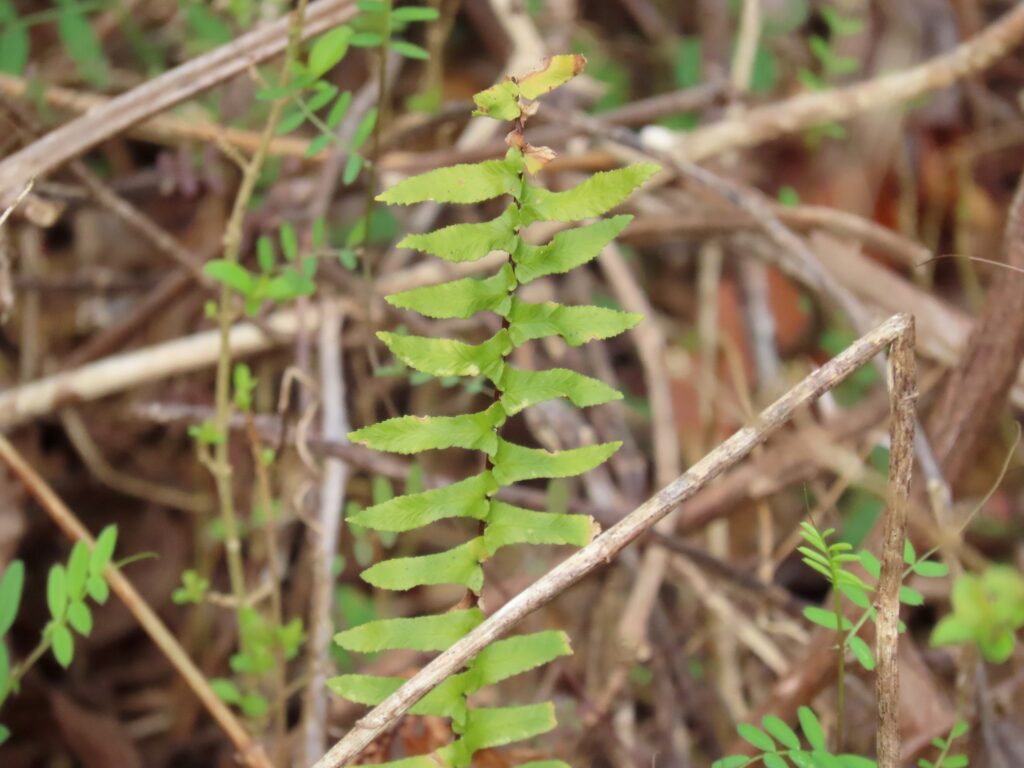

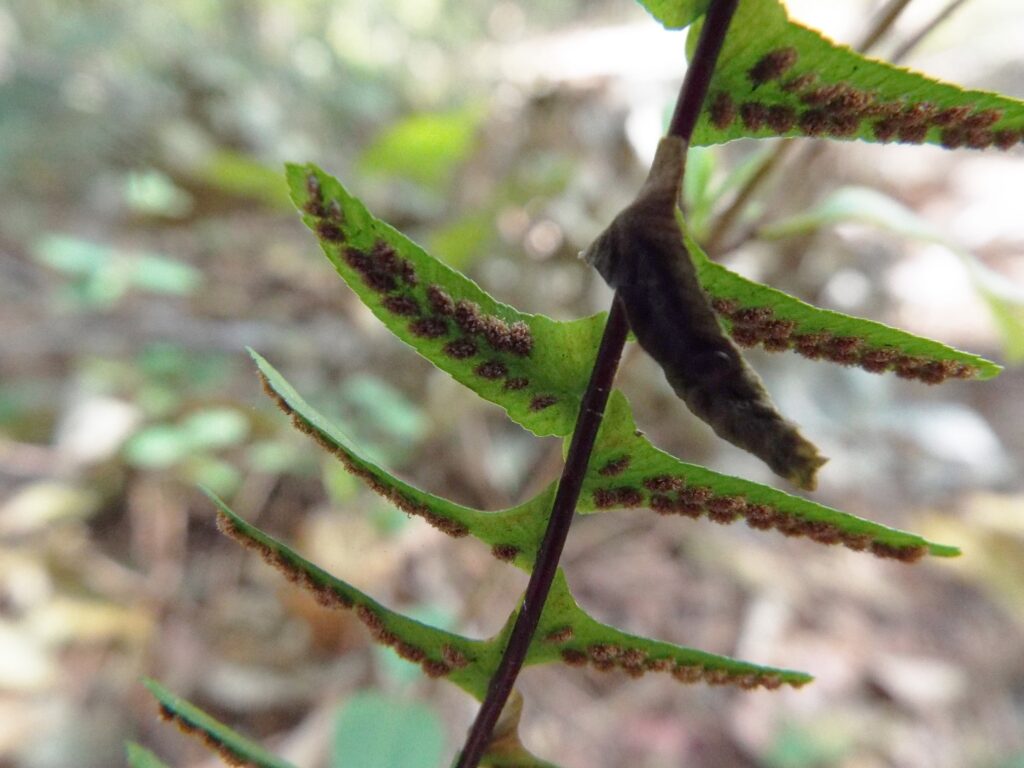

This week for Flora and Fauna Friday it’s a ubiquitous upland fern found from the foothills to our forested floodplains, Ebony Spleenwort (Asplenium platyneuron).
Ebony Spleenwort is a small, perennial fern common throughout all of South Carolina and the whole of the Eastern United States. It has narrow fronds about an inch wide and a foot long with a rather simple feather-like shape. The fronds have only one level of division, with many short and rounded leaflets, or pinnae to be precise, arranged alternately along the central rachis. That rachis is a deep ebony-black in color and gives this fern the first part of its common name. The “spleen” part of their common name is a reference to the shape of their sori, or the spore producing structures on their reproductive leaves. The sori of spleenworts are, well, spleen-shaped. Does a spleen really have a specific shape? No, not really. They’re kind of just a lumpy semi-circle. Also “wort” just means plant. Regardless of any namesake spleen-shaped features, the black rachis and thin, simply shaped fronds make Ebony Spleenwort one of our easiest ferns to identify. Which is a good thing because it’s everywhere!
Ebony Spleenwort can be found growing out of cracks in rocks in the Appalachian Mountains, peppering the forest floor in the piedmont uplands, cresting sedimentary ridges in our coastal floodplains, growing beneath our Oaks here on the Sea Islands of the Lowcountry, and even out the mortar of old chimneys and brickwork. It’s hard to find a corner of the Carolinas where it isn’t. Like all ferns, Ebony Spleenwort reproduces via spores, which float listless on the wind to far off lands. However, unlike some of our other prolific ferns, Ebony Spleenwort doesn’t form colonies through root propagation. Yet, it does have a unique adaptation to life in the forest. Ebony Spleenwort can produce “proliferous buds” near the base of its fronds. These don’t let the plant spread laterally but they do help it move vertically. If the plant becomes buried in leaf litter or sediment, rather than be smothered, it can shift its growth upward an inch or so to keep on growing in the same spot.

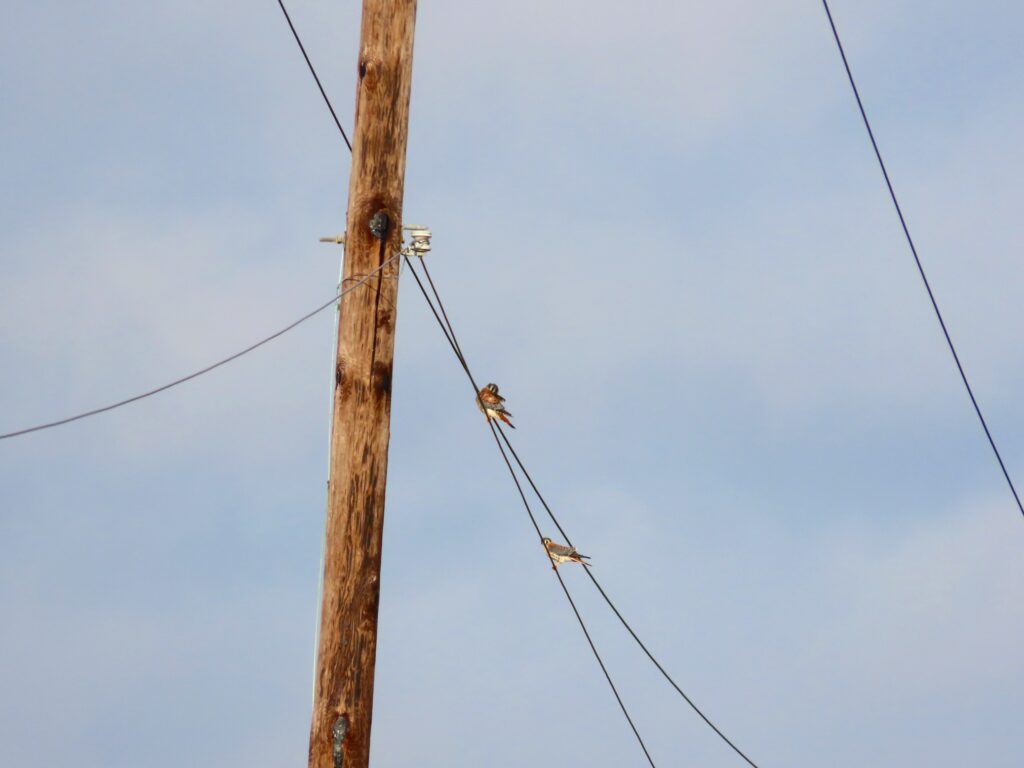
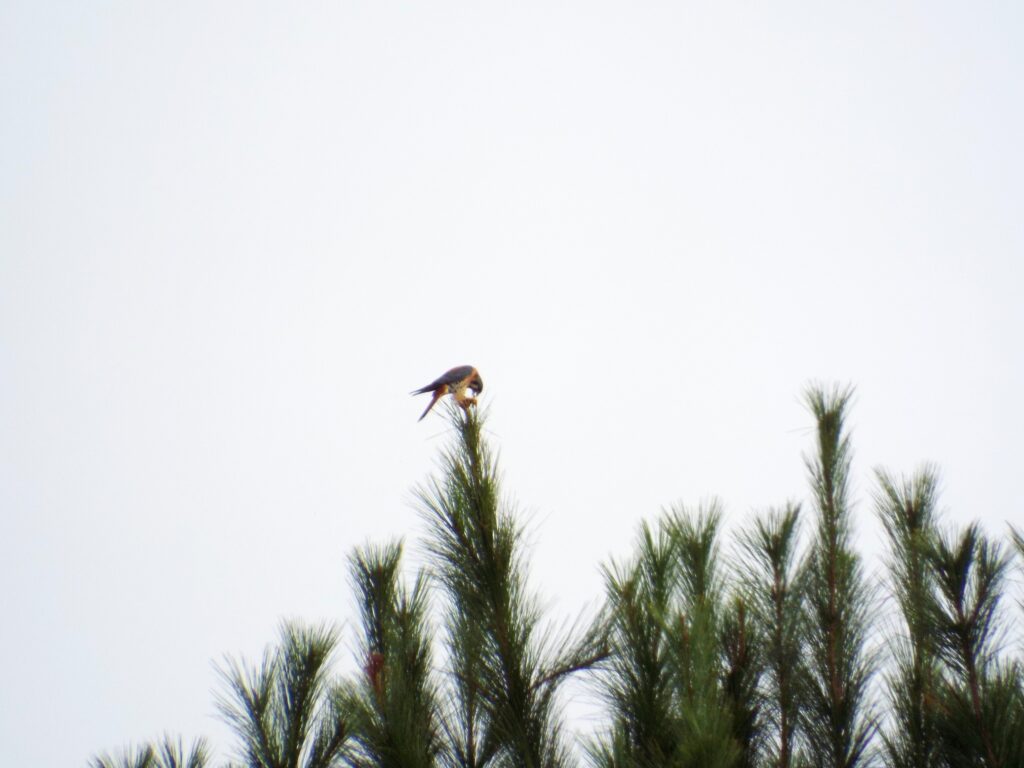
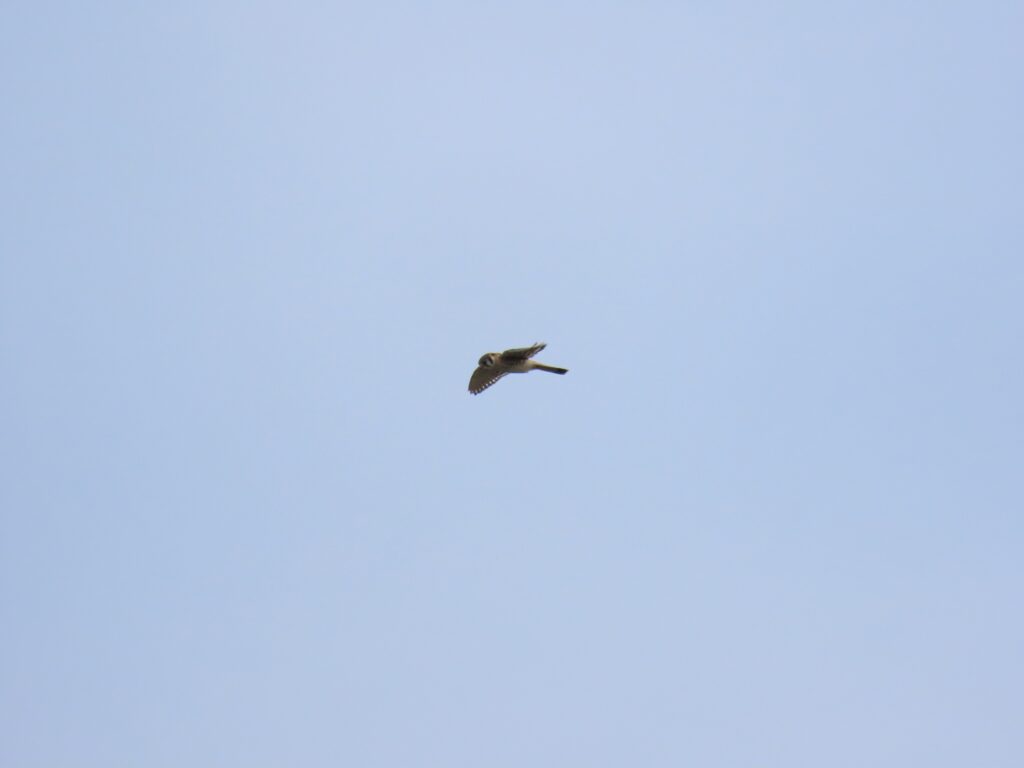
This week for Flora and Fauna Friday we have our smallest raptor, the American Kestrel (Falco sparverius).
The American Kestrel is the most petite of all our raptorial birds and a member of the Falcons. They only weigh a few ounces, are usually less than a foot in length, and are quite similar in size to a Mourning Dove or Blue Jay. Kestrels can be found year-round all across South Carolina. However, they are most common on Edisto Island in winter and most easily found in fields, pastures, and clear-cuts. American Kestrels are an easy bird to recognize. A pewter-gray cap, a short hooked bill, a wash of black running down from a large dark eyes around white cheeks, a rust-red mantle, a rust stained breast, golden-yellow legs, and a tail with a black and white fringe. Males and females have distinct patterns. Males have gray wings, an un-barred red tail, and black spots along their flanks. Females have wings checker-boarded in rusty reds and browns, thin bars across the tail, and vertical streaks down the breast.
Like all our Falcons, Kestrels are built for speed. They have relatively long, pointed wings, which allow them to fly and maneuver at very high speeds. They use this high-speed maneuvering to great effect while hunting. Kestrels subsist on a diet of large insects, small mammals, and songbirds. Their other common name, Sparrow-Hawks, was born from their skill at hunting sparrows. Kestrels hunt by perching atop a shrub, sapling, corn stalk, fencepost, power line, et cetera in a clearing and scanning their surroundings for movement. When prey is located, they swoop in to grab it off the ground, or out of mid-air if it tries to bolt. Although Kestrels rely on open habitats to hunt, they also depend on woodlands. Kestrels are cavity nesters and utilize old woodpecker holes in dead trees to build their nests. Kestrels will also use artificial nest boxes. In fact a Wood Duck Box, if mounted high enough, can serve as a suitable nest box for both Screech Owls and Kestrels. However, a slightly shorter box is usually preferred if your goal is to attract either of these two wee raptors.

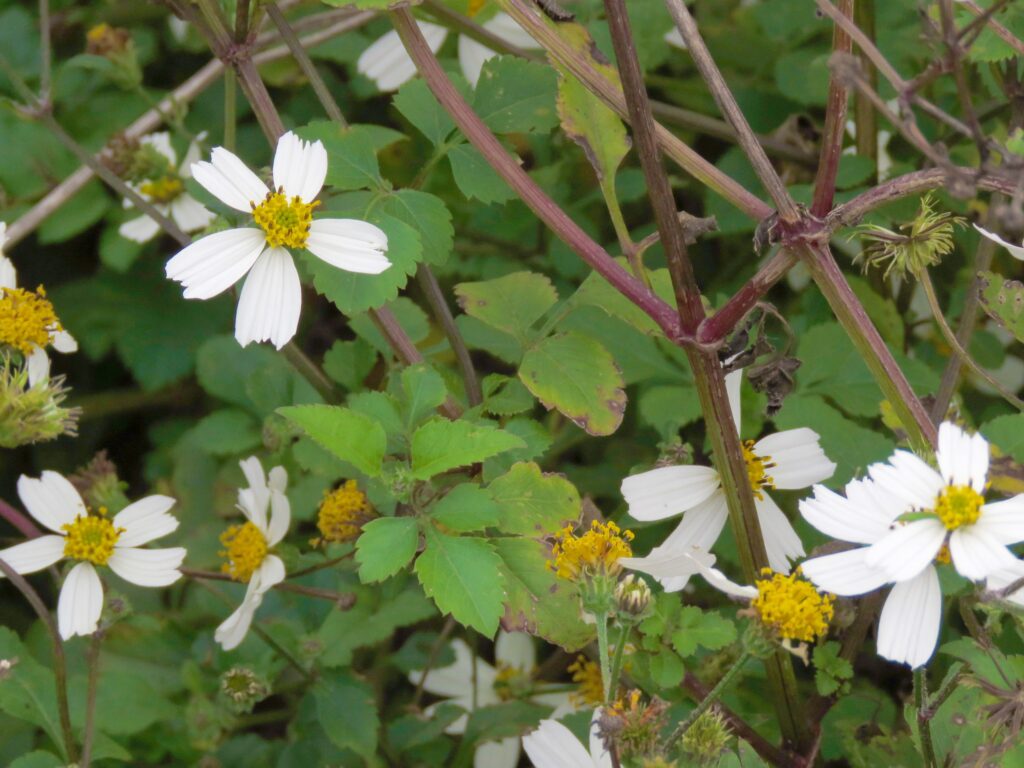

This week for Flora and Fauna Friday, we have a vigorous sub-tropical wildflower with late season staying power, White Beggarticks (Bidens alba).
White Beggarticks is native throughout Florida, the Gulf Coast, and the Sea Islands of Georgia and South Carolina, to include Edisto Island. It is an annual wildflower which typically grows knee to waist high. White Beggarticks is most abundant in damp, sunny, disturbed sites but can tolerate an extensive range of soil types and moisture levels as long as it gets enough sun. It is especially common on roadsides, power line right-of-ways, and the fringes of parking lots. It can easily be picked out from a crowd due to its inch wide daisy-like flowers with a golden center ringed in a half-dozen or so brilliant white, rectangular petals. As a sub-tropical wildflower, White Beggarticks doesn’t always follow the normal seasonal flowering convention most of our native plants do. Instead, it can bloom practically year-round if conditions are right but usually flower density peaks in mid-spring and mid-fall. Their flowers are a magnet for pollinators, especially our tropical migrant butterflies. As it has a tropical nature, this wildflower will just keep blooming, even well into winter, until a hard freeze kills it back. The seeds of White Beggarticks are shaped, and function, like a harpoon. Each of the long, thin seeds is tipped with two or three barbed prongs, which readily cling to fur and clothing. This is where the common name “beggar-ticks” comes from and this hitchhiking nature is how the seeds disperse themselves. As mammals wander past the plant, these seeds cling to their body only to be later brushed off many yards, or sometimes miles, away. There are even backwards facing barbs along the seed body itself, to aid in it later dislodging. White Beggarticks are very easy to grow and do well in cultivation. However, they are an extremely prolific seed producer and a rabid volunteer. Their clingy seeds can also be especially annoying to pick out of your jean legs and often result in the plants suddenly hopping to unexpected locales around the neighborhood. So think wisely before plugging one into your pollinator garden, as you may get a lot more of them than you bargained for!
Howdy everyone! This is Tom Austin, your quasi-resident Island ecologist and the Land Protection Specialist for the Edisto Island Open Land Trust. As some of y’all know, I’m the ghost writer and photographer behind the Flora and Fauna Friday social media series. We’ve been posting that series weekly since July of 2017. I’ve personally written every article and taken every photo for it. Today I’m excited to announce that, henceforth, we are going to house the series on this here EIOLT website, and post it here simultaneously with the regular posts on Facebook and Instagram.
I’m doing this in order to create an evergreen catalogue and searchable archive of all the posts I’ve made thus far. This means that these posts will now begin appearing in search engines and will be available for everyone to view, not just the folks who follow us on social media. This will be great for anyone who wants to find an old post and will allow EIOLT to passively reach a wider audience.
I’ve just finished posting the entire backlog of >300 Flora and Fauna Friday articles here in chronological order, back-dated to their original post date. From now on, I’ll drop new articles here on the website simultaneous to their respective social media posting.
Lastly, I’ve got a special Flora and Fauna project that’s been in the works for over 3 years now. More to come on that by the end of 2024. I’ll holler at you then!